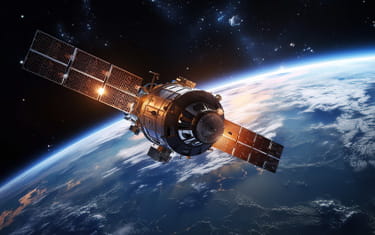The new space race: Managing disputes risks in a lawless and limitless environment
Related people
Contents
The dynamics of the new space race significantly increase disputes risks as space becomes more congested and the competition to get ahead intensifies.
Until recently, the thought of humans reaching outer space as tourists in a vehicle built by a private corporation was unfathomable. Yet, in a very short period of time, this development has become one of the least interesting aspects of the commercial space sector today due, in large measure, to the wave of ambitious new entrants in the race to exploit the strategic and economic opportunities over the horizon. Today, outer space exploration is at an inflection point of limitless possibilities.
The commercial space industry is not wanting for challenges. The most notable from a legal perspective is that regulatory regimes have been unable to keep pace with the rapid innovation in the sector. The international legal framework that was developed for regulating activities in outer space was formulated in an era when only a small number of governments had the ability to access outer space.
While in some jurisdictions new domestic legislation (such as the UK Space Industry Act 2018) has created a general framework at a national law level for certain spacefaring activities, in other jurisdictions the legislative framework is exceptionally fragmented, and needs to be updated and expanded each time a new category of space activity emerges. As a result, commercial parties have to map through an extensive array of regulations and regulators to understand their legal obligations and – where necessary – obtain authorisation for their activities.
The emergence of new technologies and the nebulous nature of the applicable regulatory frameworks have shone a spotlight on legal risks and potential disputes that may arise. The boom in commercial space activity has compounded these risks.
Even though investments have been made in the space sector since the 1950s, what has changed today is who these investors are and what forms their investments are taking. When the sector remained a monopoly of a small number of governments, disputes were always resolved by negotiation. However, as private capital is invested in the industry, we are witnessing an increased focus on ascertaining how liability would be assigned and investments protected.
More broadly, despite the extraterritorial element of outer space, disputes in the sector remain essentially terrestrial. Therefore, the way in which the sector ultimately manages the unique risks involved in space exploration will be informed by how disputes in traditional sectors are already being managed.
As the law grapples to address the concerns of such private parties, we are at a stage in the “risk tide” – a conceptual model A&O has developed to illustrate how the risk of disputes in emerging areas evolves over time – where the likelihood of disputes is increasing.
The dynamics of the new space race
The new space race is driven by private organisations, including both large companies and start-ups that are investing in and contributing to space exploration. These disruptors are creating new technologies that have the potential fundamentally to change how we live.
The expected growth of the sector is astonishing. In January 2023, McKinsey reported that the commercial space industry has grown to approximately USD447 billion – up from USD280 billion in 2010 – and could grow to USD1 trillion by 2030.
The number of satellites has also increased exponentially in the last decade. According to Statista – a specialised data gathering platform – in 2013, there were 1,187 active satellites. By the end of 2022 this figure had increased to 6,905. Growth is expected to continue apace, with McKinsey estimating that there will be 65,000 new communications satellites and 3,000 non-communication satellites over the coming years. In total, private entities have proposed more than 100 new satellite constellations.
Despite this explosion of activity, the full potential of the private sector in commercial space operations is yet to be realised. For the sustainable advance of the new space race, it is fundamentally important that a conducive ecosystem for the management of risks is created.
We have analysed the status of this ecosystem by focusing on two significant areas of disputes risks facing the commercial space industry:
- Collisions between satellites and the broader issues related to space debris and orbital congestions. There is a strong likelihood of disputes in this area in the not-too-distant future.
- The potential for disputes related to space travel and tourism. Although these particular risks may seem relatively niche today, they are likely to grow in the medium term as space travel becomes more reliable and affordable. Indeed, space tourism is forecast to generate annual revenue of approximately USD8 billion by 2040.
Satellite collisions and space debris
With so many satellites already in orbit, the problem of space congestion is a serious current threat. And the risks are growing and evasive manoeuvres are commonplace. In fact, collisions damaging active satellites are no longer in the realm of conjecture. In 2009, Iridium 33 and the defunct Kosmos 2251 collided, providing the first instance of a hypervelocity collision between two satellites. Following this collision, there was a disagreement between the operators of the satellites in the U.S. and Russia about who was at fault.
In March 2021, a Chinese satellite, Yunhai-1(02), was destroyed after reportedly colliding with space debris from a Russian satellite launch. In the end, neither of these incidents crystallised into disputes between the countries.
According to the European Space Agency, there are more than two trillion pieces of debris orbiting the Earth. Inevitably, as the amount of debris grows, the probability of catastrophic collisions will increase. Even absent a collision, a satellite operator may suffer financial losses due to debris, including higher operational costs because of increased avoidance manoeuvres, a disruption to the provision of services or because the original orbital position is no longer viable. The Organisation for Economic Co-operation and Development (OECD) recently reported that “the full range of protective and debris mitigation measures (eg shielding, manoeuvres and moving into graveyard orbit) may amount to some 5-10 % of total mission costs, that often range in the hundreds of millions of dollars”.
At an international law level, States are liable for the acts of their national space operators (including private organisations). The primary instrument in this regard is the 1972 Liability Convention (the Convention on International Liability for Damage Caused by Space Objects). Significantly, this international law regime does not apply directly to private operators, who will need to rely on their home States’ diplomatic protection to receive compensation. Private party liability for damage caused in space is primarily addressed at a national law level, including by legislation, which is still evolving.
Statutory claims
To offset their international liability, States generally use domestic legislation to require spacecraft operators to carry liability insurance or accept responsibility for any international liability that may occur because of their actions.
Similarly, States are beginning to impose space debris mitigation responsibilities on operators. These responsibilities are often based on voluntary international ‘soft law’ guidelines that have been drafted by various national space agencies or the UN Committee on the Peaceful Uses of Outer Space (COPUOS).
This means that some claims arising from collisions are likely to be statute-based. For instance, if a satellite owned by an entity operating out of Hong Kong causes damage to another satellite, and the Government of Hong Kong or of the People’s Republic of China was required to pay compensation under international law, the Outer Space Ordinance (Cap. 523) would allow the governments to pursue a claim against the satellite operator to indemnify it against that international liability. This may be in addition to regulatory action such as licence suspension or revocation.
A key risk for operators under the statutory regime is that most commercial space legislation is untested. As a result, there is uncertainty about the scope of the liability they may face if they have to indemnify the government against international liability.
Claims under the law of obligations
The most obvious claim would be a claim for negligence for failure appropriately to control a satellite or remove debris. A crucial stumbling block may be in establishing fault. This would require parties to provide evidence to establish responsibility for the collision, which would not be easy in relation to events happening in space and may be impossible where the damage is caused by unidentifiable debris.
Additionally, a claimant would have to show that the operator had failed to comply with applicable standards or best practices in order to prove that a duty of care had been breached. Such standards have not yet been codified or globally accepted.
Despite these limitations, given the sums at stake, claims under the law of obligations are likely to arise as the possibility of collisions increases. A number of companies (particularly space start-ups) have developed space situational awareness systems aiming to detect and track space objects and debris. As this sector matures, these services will play a key role in providing collision risk information to guide avoidance manoeuvres, as well as evidence in case of disputes.
Contractual claims
It is unlikely that there will be a contractual relationship between parties whose satellites are involved in a collision. However, it is possible that contractual claims may arise in such scenarios, for example if a collision is caused by a defect in a satellite. Whether liability arises in that scenario will of course depend on the terms of the relevant contract, and in particular any exclusions of liability.
Moreover, satellite operators are likely to enter into insurance contracts to protect themselves from losses that may arise from collisions. Currently, insurance is available to commercial space operators for damage to satellites arising from all eventualities, including collision with debris, malfunctions or design flaws. However, orbiting debris, especially in the lower Earth orbit, is creating a challenge due to the high likelihood of collisions. As such, insurance covers are becoming more complex and lower in value. It is likely that traditional insurance disputes between insurers and insured may arise (and indeed we have already seen some of these disputes).
Investment treaty claims
In general, international investment treaties protect foreign investors against frustration of their legitimate expectations and arbitrary, expropriatory or discriminatory actions taken by a State in which that investor has made an investment (provided, of course, that such a treaty is in place between the investor’s State and the State in which the investment is made).
Various investment treaty claims have arisen from other space-related activities, and similar claims may arise in the context of collisions and debris generation.
Among other scenarios, an investment claim could in theory arise if:
- a State refused to pursue a claim under the Liability Convention on an investor’s behalf for discriminatory reasons;
- a State took enforcement action against an investor for causing a collision or generating debris if it could be shown that such action was expropriatory, arbitrary or irrational; or
- a State failed to carry out debris removal (or removed an asset that should not have been removed) and as a result hindered an investor’s operations in space.
The future
Currently, most of the world relies on the U.S. Department of Defense to collect and analyse data on objects in the increasingly congested lower Earth orbit. Warnings regarding collision risks are often rendered meaningless by significant margins of error.
In these circumstances, satellite operators may be able to mitigate some risks through space insurance. However, there are some substantial drawbacks. Premiums are between 10 to 20 times those of aviation premiums. Furthermore, the increased collision risks have led some insurers offering relevant satellite coverage to pull back in providing such policies.
In light of these challenges, the decongestion of Earth’s orbit to mitigate collision risks and related disputes remains a crucial goal, especially as the number of commercial players in the industry continues to increase.
That is all the more so as most domestic legal frameworks remain in development or are untested, the only notable trend being that domestic legislation increasingly requires satellite operators to present end-of-term and debris mitigation measures as a condition for the licence to operate.
In the future, governments are likely to have to seek to co-operate through international bodies such as COPUOS to foster co-operation and avoid further collisions, although the current geopolitical climate will no doubt mean it is difficult to achieve consensus.
More broadly, a key takeaway for businesses in nascent industries is that they must consider the entire cycle of their investments and undertake a comprehensive review of regulatory regimes to understand what risks may arise, and who may pursue claims against them. Where contractual relationships exist, it will be important for businesses to negotiate appropriate terms allocating any identified and predicted risks and wider protections should something go wrong (including well drafted dispute resolution provisions) with a view to mitigating future disputes risks.
Disputes arising from space tourism
Space tourism is still the preserve of ultra-high net worth individuals, but the market is expanding at a rapid pace. Private companies are developing plans for gravity-capable space stations in-orbit, with the goal of enabling humanity to work, play and “thrive” in outer space.
Much like the commercial space sector generally, entities operating in space tourism face significant legal risks, including challenges in complying with existing and emerging regulations in different jurisdictions that impact licensing of such activities and the liability arising from them.
These come on top of technical and operational risks, which present barriers to entry because of the high costs associated with developing, testing and launching space objects. Despite these hurdles, however, as launch costs decrease, space tourism is likely to become more mainstream.
There are several companies already competing in this sector including Virgin Galactic, Blue Origin, Boeing and Axiom Space. As the industry matures, companies specialising in space tourism are likely to have opportunities to leverage their unique capabilities to explore new markets, such as sub-orbital space flights, which would help broaden our current conception of space tourism.
The legal framework for space tourism
The space tourism industry does not fit neatly into the current structures of international law. For a start, it requires transition from airspace into outer space which means that both international space law and international air law are likely to apply to space tourism. This hybrid approach creates complexity and potential for confusion. For example, international space law only provides for third-party liability, but international air law includes both third-party liability as well as liability to passengers.
Moreover, international space law was developed at a time when private spaceflight was not in contemplation. It is unclear therefore how international law applies in this sector. For example, there are doubts as to whether the wide humanitarian obligations regarding the rescue and return of passengers on spaceflights apply to space tourists. In practice, this raises the crucial question of whether space tourists could be classified as ‘astronauts’ or not. To avoid this controversy, governments have proposed the development of a specific multilateral framework to regulate commercial private space travel. This plan remains under development.
National laws applicable to the space tourism industry sit alongside the international law regime. Several countries have implemented or are implementing legislation to regulate space tourism.
The United States was the first country to take substantive steps to address private space flight by amending the Commercial Space Launch Act 1984, granting the Federal Aviation Administration the authority to issue licences for space tourism operations to private operators. Since then other countries have also adopted specific legislations to govern space tourism.
Another key consideration is that parties in the space tourism sector regulate their relationship contractually. Contracts will be concluded between a space tourist and an operator, as well as between other parties involved in a tourism operation, including insurers and spaceflight training providers. In future, operators are also likely to enter into lease agreements with spacecraft manufacturers, similar to the case in the aviation sector.
Cross-waivers of liability are likely to shift nearly the entire burden of risks to the tourists themselves, although this may well be subject to statutory limits. Space tourists will need to understand the risks they are taking and the extent of any limit on their ability to bring a claim if a problem occurs. The position will be different under different laws. For instance, under the UAE’s Federal Law no. 19 of 2019 on the regulation of the space sector, it is unlikely that an operator would be able to restrict its liability for death or personal injury arising from negligence through a contract with a space tourist. This is not the case under U.S. law. Following the enactment of the Commercial Space Launch Competitiveness Act 2015, U.S. federal law explicitly requires space tourists to waive any claim they might have for injury or death caused by a commercial space operator’s negligence.
What are the disputes risks?
Let us take a hypothetical scenario that illustrates the types of disputes that may arise.
Star Adventures, a UK space tourism agency, signs a deal with a French company, SpaceFlight, to use one of its spacecraft to fly four tourists to the International Space Station. A U.S. company, MilkyWay, trains the tourists. SpaceFlight delays the delivery of the spacecraft by six months, and due to the delay one tourist backs out of the spaceflight. The remaining tourists successfully complete their trip to the International Space Station but on their descent into the Earth’s atmosphere, they suffer injuries because of a lack of training on how to manage the re-entry manoeuvres.
There is scope for a wide range of disputes to arise from this scenario. For a start, the tourists may have claims for personal injury against Star Adventures. These claims may arise under the contract between the tourists and Star Adventures or under the tort of negligence, assuming liability is not excluded. In relation to claims in negligence, novel conflict of laws issues are likely to arise. Based on traditional principles of conflicts of laws, parties are commonly able to bring proceedings in the jurisdiction where the defendant is domiciled. However, it is equally commonplace for claimants to be able to choose to litigate tortious claims in the jurisdiction where the damage occurred. Similarly, in many jurisdictions, the governing law of a claim in negligence would usually be the law of the country in which the damage occurs. These rules would not operate effectively where damage occurs in outer space.
In respect of the delay in the spaceflight, the tourist who missed the flight may bring a contractual claim against Star Adventures. There may be a consumer law or broader statutory overlay too. Claims against airline operators for cancelled or rescheduled flights are regulated based on national laws (i.e. if you are flying within the EU, the relevant EU regulations apply), although it remains to be seen whether sub-orbital space flights would be captured by regulations that have until now been used for the airline sector. A contractual claim may also arise between Star Adventures and SpaceFlight because of the delay, again assuming liability is not excluded.
Other kinds of disputes may also arise, for example if it were established that MilkyWay provided inadequate training to the tourists.
This hypothetical scenario illustrates the types of disputes that may arise from the space tourism sector as we know it today. As the number of actors increases and the space tourism sector diversifies, the potential disputes are also likely to increase, with disputes involving insurers, national space agencies and potentially governments under investment treaties, all looming.
Conclusion
As the commercial use of outer space grows, it presents us with an issue commonly seen in rapidly developing and disruptive industries. The laws and regulations that govern the commercial space sector have failed to keep pace with the innovations that continue to shape and evolve it. Consequently, incumbents and new entrants need to be agile and responsive to keep up with regulatory developments and potentially recalibrate their business models to avoid disputes risks.
The process of restructuring the legislative regime to reflect the new reality has already begun, with regulation around the world at various stages of development. As commercial innovation continues at pace, it is essential that the law keeps up and also that it finds the right balance, regulating activities in a proportionate way that ensures that innovation and commercial appetites are not stifled.
As the sector grows there will be a period in which disputes risks are heightened. This is common in many novel and disruptive industries. That said, it is evident that the benefits that commercial parties are likely to gain from outer space outweigh such risks, which is why the sector has continued to flourish despite regulations being underdeveloped. Commercial parties must nevertheless remain vigilant in relation to such disputes risks, which are likely to be costly and potentially damaging for an industry that requires a heavy and continuing influx of capital. In such a fast-evolving and dynamic sector, understanding and management of disputes risks is likely to be a key competitive differentiator.
A brief checklist for mitigating future disputes risks
- Risk assessment – Conduct thorough due diligence and risk assessments before entering into transactions.
- Contractual protections – As the commercial arrangements are complex and technical, it is essential to negotiate clear, comprehensive and enforceable contracts as well as dispute resolution mechanisms in case of any breaches.
- Strong relationships with key stakeholders – As the number of players in the commercial space industry increases, companies should establish effective channels of co-ordination with their counterparties as well as regulators to assist in fostering co-operation between all stakeholders.
- Best practices and common standards – Companies may wish to work with governments and national space agencies to foster the development of uniform guidelines for the operation of commercial space activities to evolve best practices for the sector going forward.















